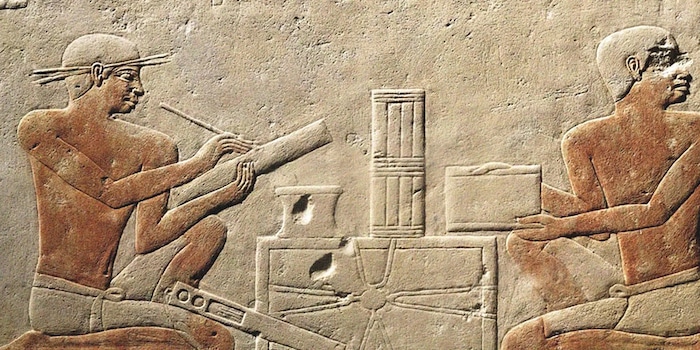
Egyptian scribes had a real back-breaking job
Desk stools are familiar with the problem of impending postural problems. But even in ancient Egypt, being a scribe was associated with certain occupational risks.
Even in ancient Egypt, those who could read and write had a clear advantage. Only around one per cent of the population managed the arduous task of learning hundreds of hieroglyphs. The reward was a well-paid job in politics and administration. Although being a scribe was significantly less strenuous than the everyday life of a member of the pharaoh's construction team, it also came with its own health risks, as a recent study shows.
Petra Brukner Havelková from the National Museum in Prague and colleagues compared the bones of 30 professional scribes from the Old Kingdom (between 2700 and 2180 BC) with those of 39 ordinary employees. This revealed some telling differences.
Typical for the scribes were signs of wear and tear in the area of the upper spine - presumably a result of staring down at the writing material. Many also had changes in the area of the right knee. Contemporary illustrations provide an explanation for this finding. Scribes did not work at a desk, but sat in one of three postures: cross-legged on both sides, half-cross-legged with the right leg raised, or kneeling on the left with the right leg raised. Brukner Havelková and her team write in the scientific journal "Scientific Reports" that the scribes remained in these positions for a long time and frequently, as can still be seen in their bones today.
The writing instrument also left its mark on the body - not only on the thumb joint, but also on the jaw: in the Old Kingdom, it was common to write with rushes, which were chewed at the tip to form a kind of brush. After years of writing, even this seemingly harmless strain led to bone changes.
The 69 skeletons examined all come from the necropolis of Abusir, which has been excavated by Czech archaeological teams since 1960. Throughout the Old Kingdom, the highest ranks of society in particular were buried in this large cemetery. In addition to lavishly decorated tombs of top officials, there are also tombs of middle and lower-ranking civil servants. The latter were identified as scribes in the current study. In many cases, occupational designations in the grave confirm this view. In six cases, the interred were even explicitly named as scribes. A certain Nefer, for example, made a real career for himself: during his lifetime, he made it to "overseer of the scribes of royal documents".
In order to obtain comparative values from the general population of the time, Brukner Haliková and colleagues also analysed skeletons from some very simple burials at Abusir. People who worked as servants in the elite environment - as domestic helpers or employees in the temples - were probably laid to rest there.
Spectrum of science
We are partners of Spektrum der Wissenschaft and want to make well-founded information more accessible to you. Follow Spektrum der Wissenschaft if you like the articles.
Original article on Spektrum.de
Experts from science and research report on the latest findings in their fields – competent, authentic and comprehensible.
From the latest iPhone to the return of 80s fashion. The editorial team will help you make sense of it all.
Show all